
Introduction: Egypt’s Lively Tapestry of Street Markets in Egypt
Street Markets in Egypt Nestled along the banks of the Nile River, Egypt stands as a living testament to the passage of time, its sands whispering tales of ancient civilizations and empires that once ruled these lands. Street Markets in Egypt It is a country steeped in history, where every cobblestone and stone monument holds secrets from a bygone era. Yet, amidst this rich historical tapestry, one of the most vibrant and enduring aspects of Egyptian culture emerges in its bustling street markets in Egypt.
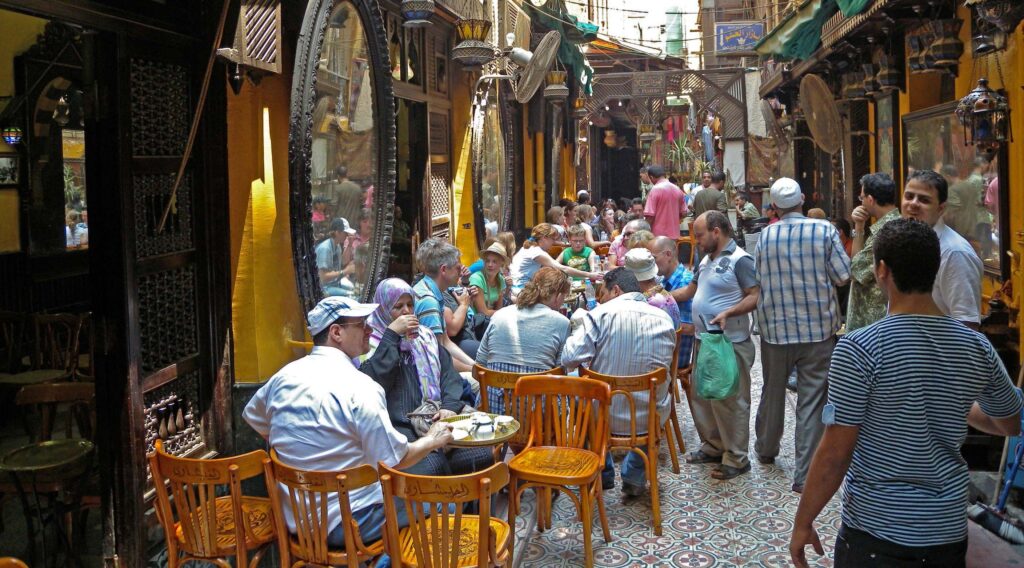
Street markets in Egypt, or “souks,” as they are fondly referred to, are not merely places of trade and commerce but veritable hubs of cultural exchange and communal gatherings. They have been at the heart of Egyptian life for centuries. Street markets in Egypt thread together the fabric of society with threads of commerce, tradition, and social interaction. The significance of these markets transcends mere economic transactions; they are the lifeblood of local communities, sustaining livelihoods and preserving age-old crafts Street markets in Egypt
In Egypt, street markets are a living, breathing entity—an arena where the past harmoniously mingles with the present, and where the scents of exotic spices dance in the air alongside the chatter of eager shoppers. The markets pulsate with an energy that is as timeless as the pyramids that dot the landscape, creating a sensory symphony that leaves an indelible mark on all who venture within.
- Cultural Exchange through Traditional Marketplaces
Stepping into an Egyptian souk is akin to embarking on a cultural odyssey. The markets serve as vivid reflections of the diverse tapestry of Egyptian society. Here, one can find a treasure trove of goods, from intricately woven textiles in vibrant hues to handcrafted jewelry that tells stories of artisans’ skills passed down through generations. Each item is a testament to the craftsmanship and artistry that define Egyptian heritage.
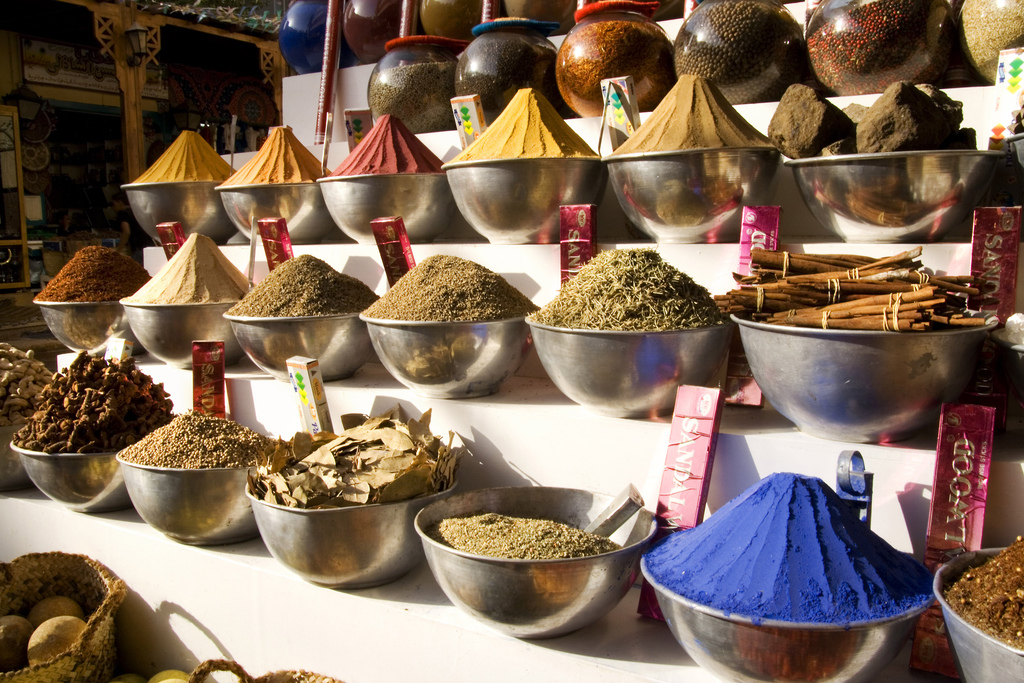
The soul of these markets lies not only in the products they offer but also in the spirited exchanges between merchants and customers. Conversations reverberate in a multitude of languages, as visitors from every corner of the globe come together in pursuit of a shared experience. This lively intermingling of cultures, this ceaseless flow of human connection, is what makes these marketplaces true crucibles of cultural exchange.
2. Iconic Markets: From Khan El Khalili to Aswan’s Nubian Market
Among the many illustrious markets that adorn Egypt, none stand as more iconic than Khan El Khalili. Nestled in the heart of Cairo’s historic center, this labyrinthine bazaar is a living testament to the endurance of tradition in a rapidly changing world. Its narrow, winding alleys are lined with stalls that beckon visitors with an array of goods, from gleaming brassware to aromatic spices.
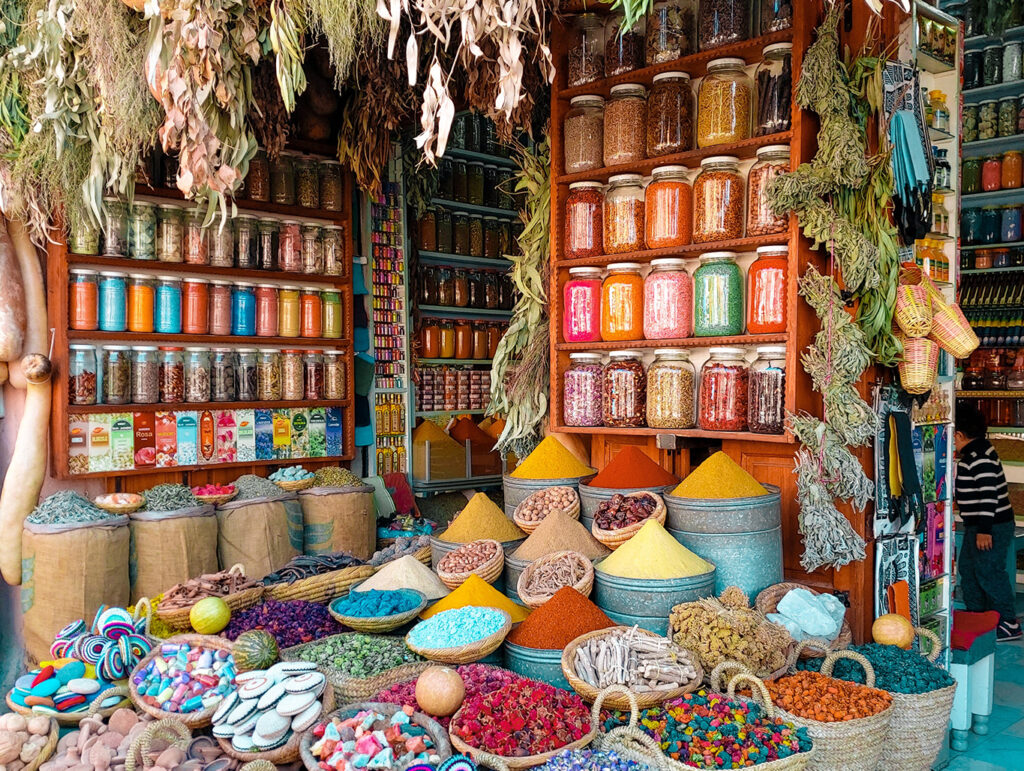
Venturing southward, Aswan’s Nubian Market offers a distinctively different experience. Here, the vibrancy of Nubian culture permeates every corner. Brightly colored textiles, adorned with intricate patterns, sway in the breeze, drawing visitors into a world of vivid expression and artistic flair. The Nubian Market stands as a testament to the resilience and vibrancy of a culture that has thrived along the banks of the Nile for millennia.
In this article, we will embark on a journey through these and other iconic markets, unveiling the stories and treasures they hold. From the spice-laden air of Khan El Khalili to the vibrant tapestries of Aswan’s Nubian Market, each marketplace offers a unique chapter in the grand narrative of Egypt’s street markets.
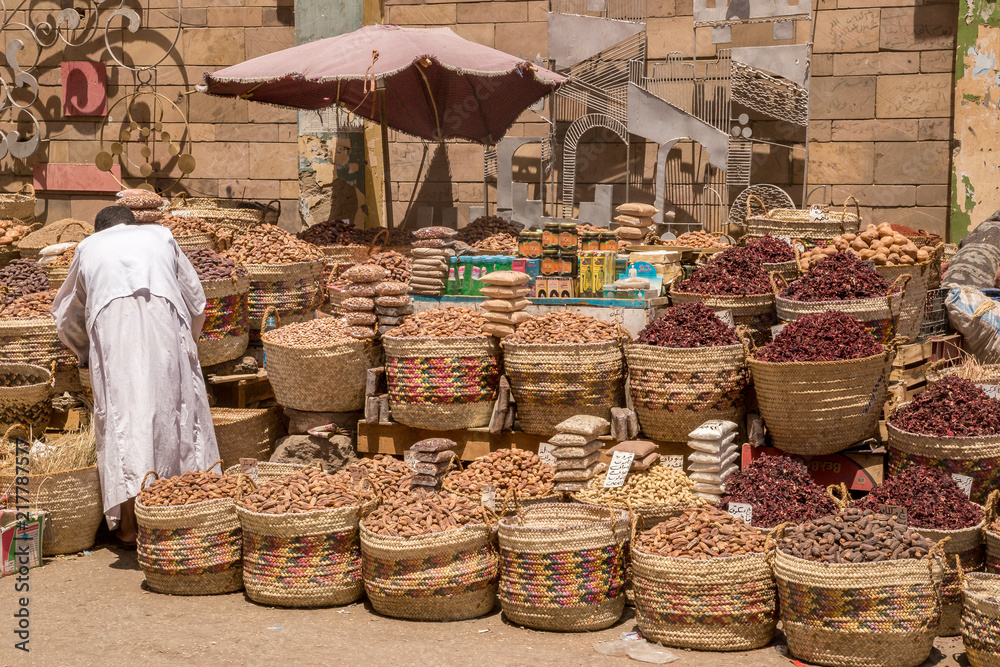
As we delve deeper, we will uncover the diverse array of products, from handwoven textiles to fragrant spices, that grace the stalls of these markets. We will savor the flavors of authentic Egyptian cuisine, explore the intricate craftsmanship of local artisans, and witness the enduring spirit of cultural exchange that defines these bustling hubs.
Join us on this odyssey through Egypt’s vibrant street markets, where the past and present entwine in a dance of commerce, culture, and tradition. Together, we will uncover the hidden gems and timeless stories that await within these lively marketplaces.
3. Historical Roots of Egyptian Markets: A Journey Through Millennia
Egypt’s vibrant markets have an illustrious history that stretches back to the earliest days of civilization. These bustling hubs of commerce, so intrinsic to contemporary Egyptian life, find their roots in the very foundations of Pharaonic society.
A.Pharaonic Beginnings
Even in the era of the Pharaohs, marketplaces held a central place in Egyptian society. The ancient Egyptians were accomplished traders, forging extensive networks that reached far beyond the banks of the Nile. Markets, then as now, were spaces where goods, ideas, and cultures converged.
B.Evolution through the Ages
As the sands of time flowed through the centuries, so too did the markets of Egypt evolve. Each subsequent civilization that left its mark on this land – from the Hellenistic influence of Alexander the Great to the Roman occupation and the Islamic Golden Age – brought new dimensions to the marketplaces.
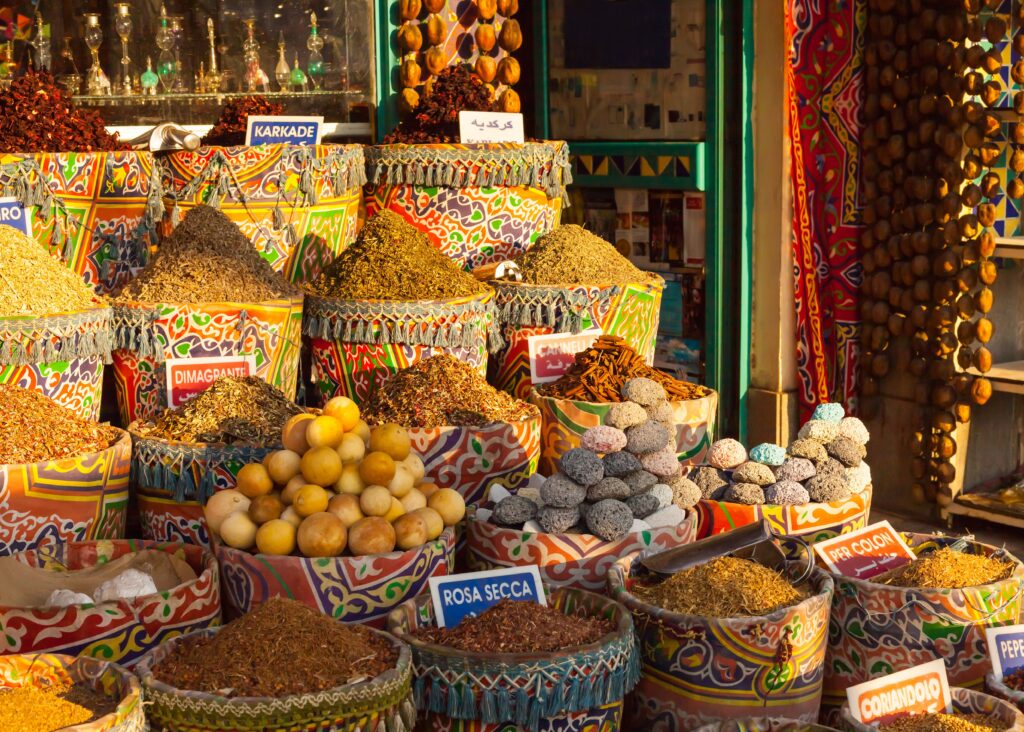
During the Greco-Roman period, the bustling port city of Alexandria thrived as a cosmopolitan center, teeming with merchants from across the known world. Its legendary fish market, which drew seafarers and traders alike, became an emblem of the city’s international character.
In Luxor, the souk emerged as a hub of trade and cultural exchange. With the grandeur of the nearby temples of Karnak and Luxor, the Luxor Souk stands as a living testament to the enduring synergy between commerce and culture.
Centuries later, with the arrival of Islam, the markets took on new significance. Islamic Cairo, with its labyrinthine alleyways and iconic Khan El Khalili bazaar, became a crucible of commerce, culture, and faith. The Khan, with its narrow lanes and vibrant stalls, has stood witness to epochs of history, its walls echoing with the voices of traders from across continents.
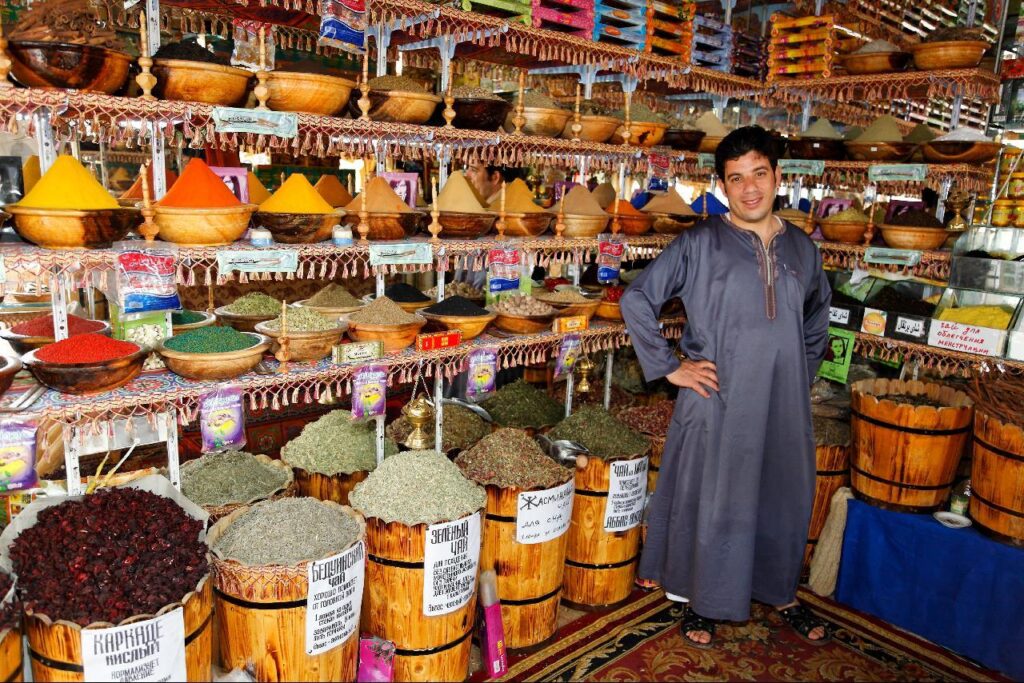
In Aswan, a different tapestry of culture unfurled. The Nubian Market, nestled along the banks of the Nile, reflects the resilience and artistry of the Nubian people. Here, the echoes of ancient African traditions resonate in the colorful textiles and handcrafted wares that adorn the stalls.
4. The Enduring Legacy
Today, as we traverse the cobbled streets and bustling alleyways of these markets, we walk in the footsteps of generations long past. The very essence of heritage permeates the air, mingling with the scents of spices and the chatter of merchants.
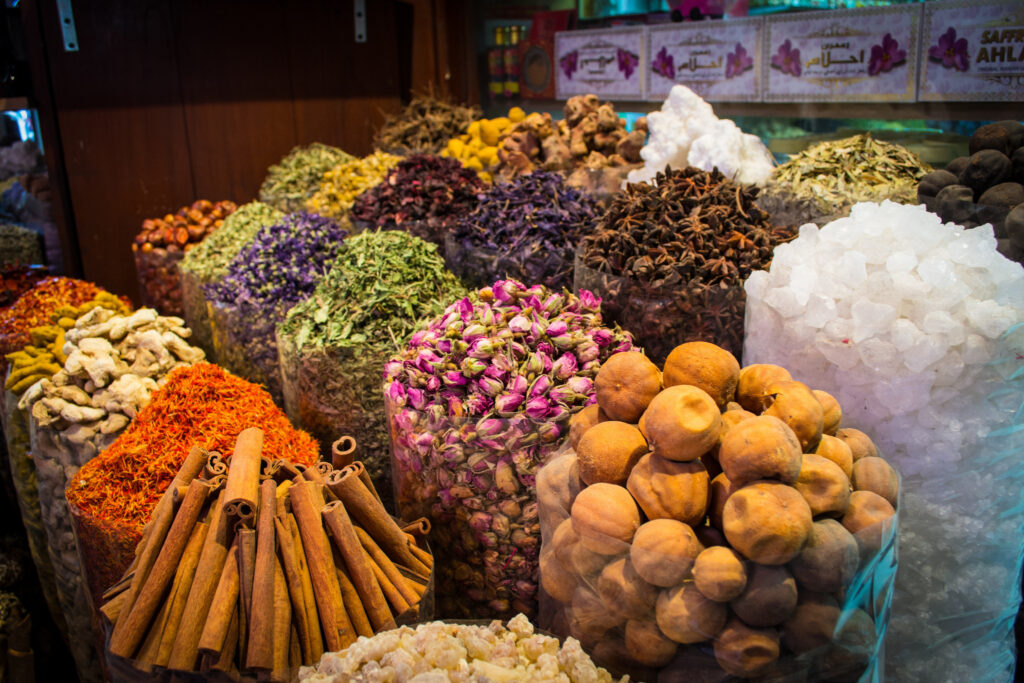
These markets stand as living monuments to Egypt’s enduring legacy, a testament to the remarkable ability of a society to adapt, grow, and thrive while remaining rooted in its traditions. They are the threads that connect us to the Pharaohs, the Greeks, the Romans, and the countless others who have called this land home.
5. Diversity of Products: Treasures of Egyptian Markets
Egyptian markets are a treasure trove of wares that span the spectrum of human craftsmanship and creativity. From the heady aromas of exotic spices to the intricate weavings of Egyptian textiles, and from the gleam of artisanal jewelry to the delicate beauty of papyrus art, these markets offer a sensory feast for visitors and a cherished source of local pride.
A.Spices: A Symphony of Aromas
Step into any Egyptian market, and you’ll be immediately enveloped in a fragrant embrace. The air is alive with the intoxicating scents of cumin, coriander, saffron, and a myriad of other spices that have tantalized the senses for centuries.

The spice merchants, with their weathered hands and knowing smiles, preside over pyramids of vibrant powders and whole spices. Each jar holds a promise of flavor, a testament to the ancient art of blending and grinding that has been perfected over generations.
These spices are the heartbeat of Egyptian cuisine, infusing dishes with layers of depth and complexity. Visitors, enticed by the exotic aromas, often leave with a handful of carefully chosen spices, ready to recreate a taste of Egypt in their own kitchens.
B.Textiles: Weavings of Tradition
Egyptian textiles bear witness to centuries of skill and artistry. From the intricate patterns of handwoven rugs to the flowing elegance of traditional clothing, every thread is a testament to the craftsmanship that has been honed over generations.
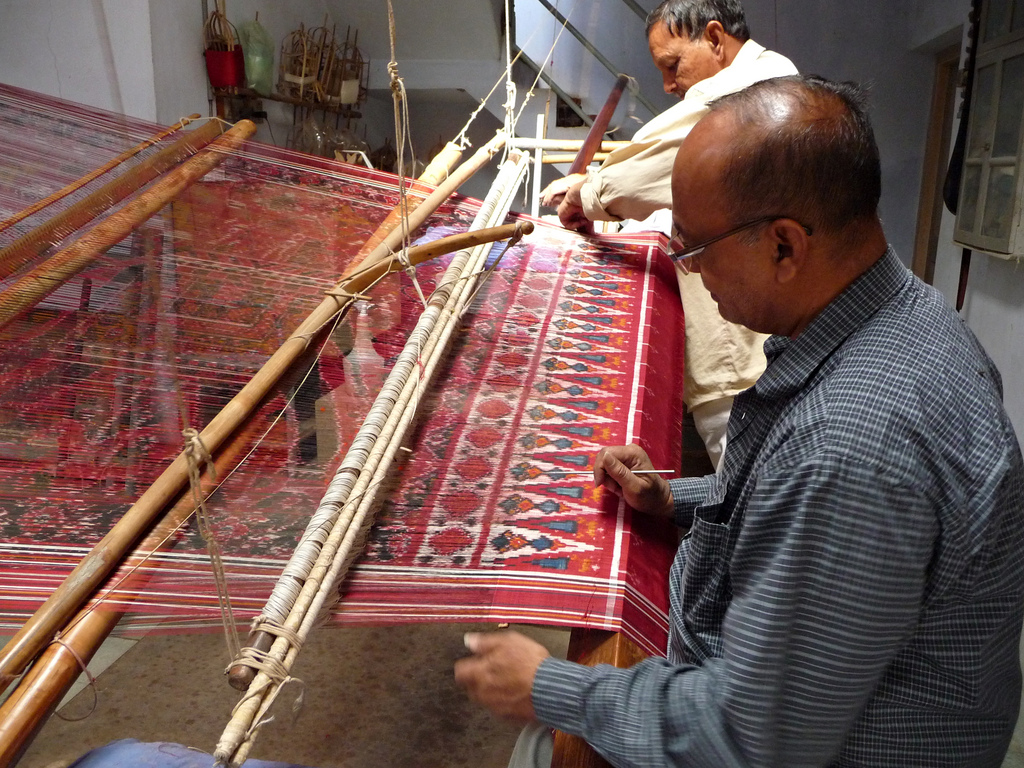
Silken scarves, adorned with vibrant geometric designs, catch the eye, while carpets tell stories through their intricate motifs, each thread a chapter in a rich tapestry of tradition. The markets echo with the rhythmic clacking of looms, as skilled artisans transform raw fibers into works of textile art.
These textiles are not mere fabrics; they are living expressions of a culture, carrying within them the echoes of generations of weavers and the soul of a people.
C.Jewelry: Adornments of Elegance
In the markets of Egypt, jewelry is more than adornment; it is an expression of identity, a celebration of heritage, and a testament to the artistry of the jeweler’s hand.
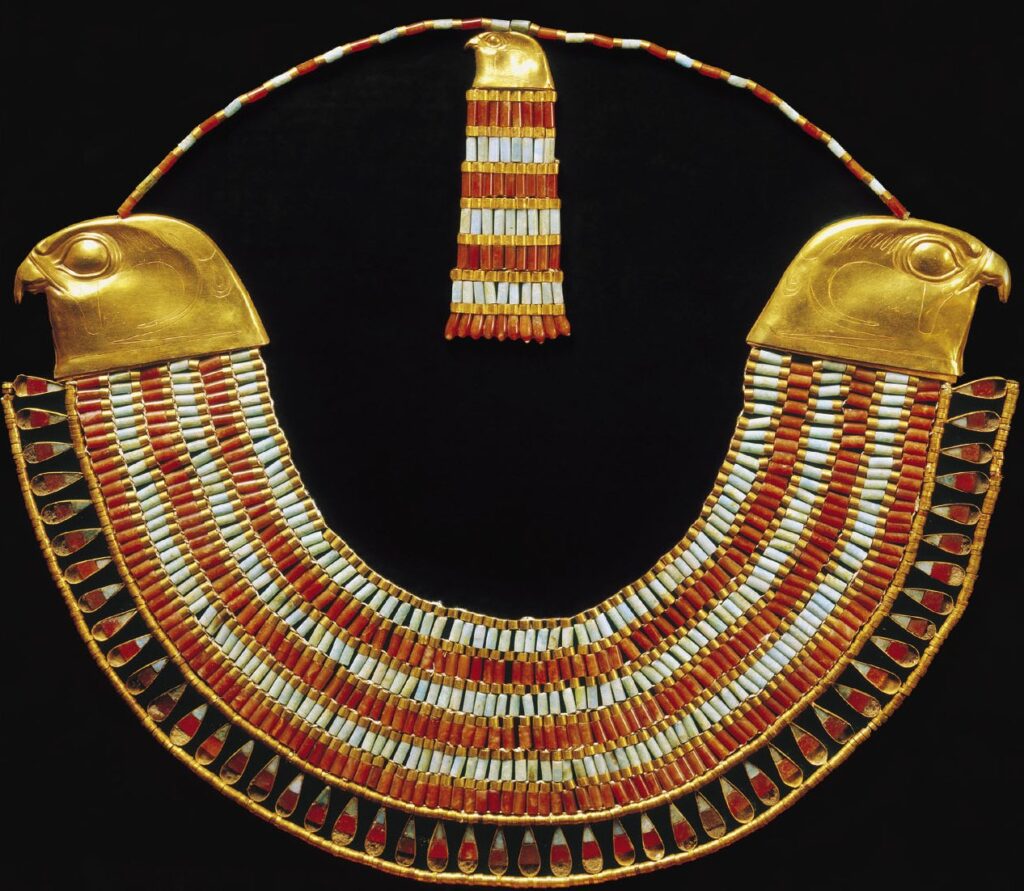
Artisanal jewelry, often crafted in small, family-owned workshops, is characterized by its attention to detail and reverence for tradition. Rings, necklaces, and earrings gleam with the luster of carefully selected gemstones, while gold and silver are molded into intricate forms, each piece a work of art in its own right.
For locals, these pieces hold sentimental value, passed down through generations as cherished heirlooms. For tourists, they are tangible memories of a journey through the bazaars, carrying with them not only the beauty of the jewelry but the story of its creation.
D.Handmade Crafts: From Hands to Heart
The markets of Egypt are teeming with an array of handmade crafts, each a labor of love and a testament to the ingenuity of local artisans. Woodworkers fashion intricate furniture and decor, while potters mold clay into vessels that are both functional and beautiful.
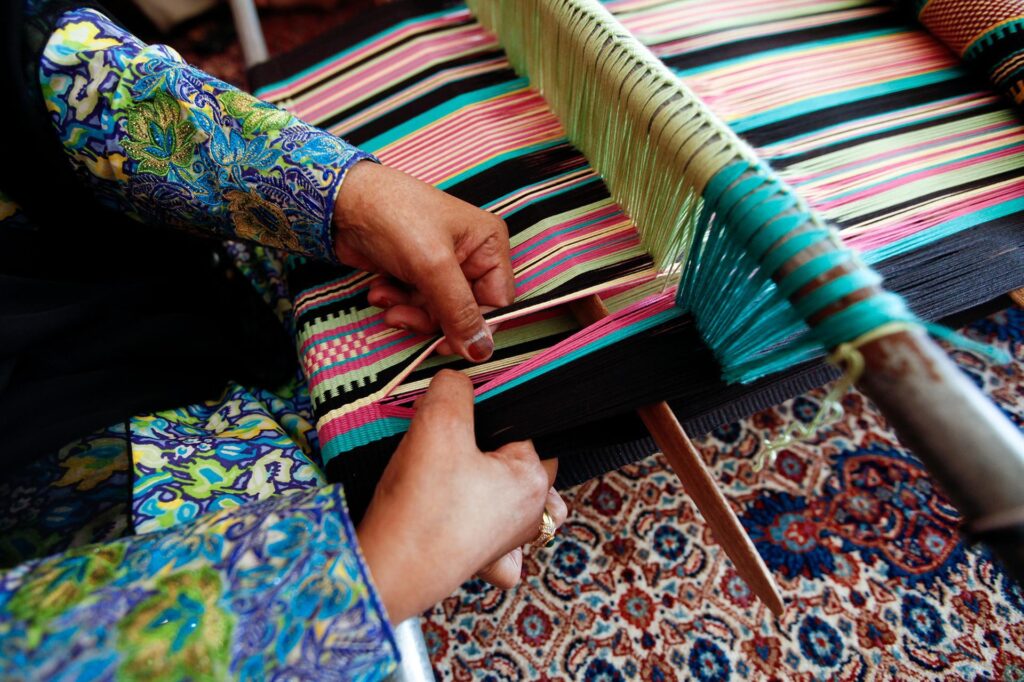
Leatherworkers ply their trade, creating bags, belts, and shoes that bear the mark of careful craftsmanship. Intricate glasswork, with its kaleidoscope of colors, catches the eye, and traditional musical instruments resonate with the promise of melodic journeys.
These crafts are not mass-produced commodities; they are the fruits of individual dedication and creativity, each piece a reflection of the artisan’s soul.
F.Papyrus Art: History in the Making
Papyrus, the ancient writing material of the Egyptians, finds new life in the markets. Artists painstakingly recreate scenes from history and mythology, meticulously painting on the delicate surface of the papyrus plant.
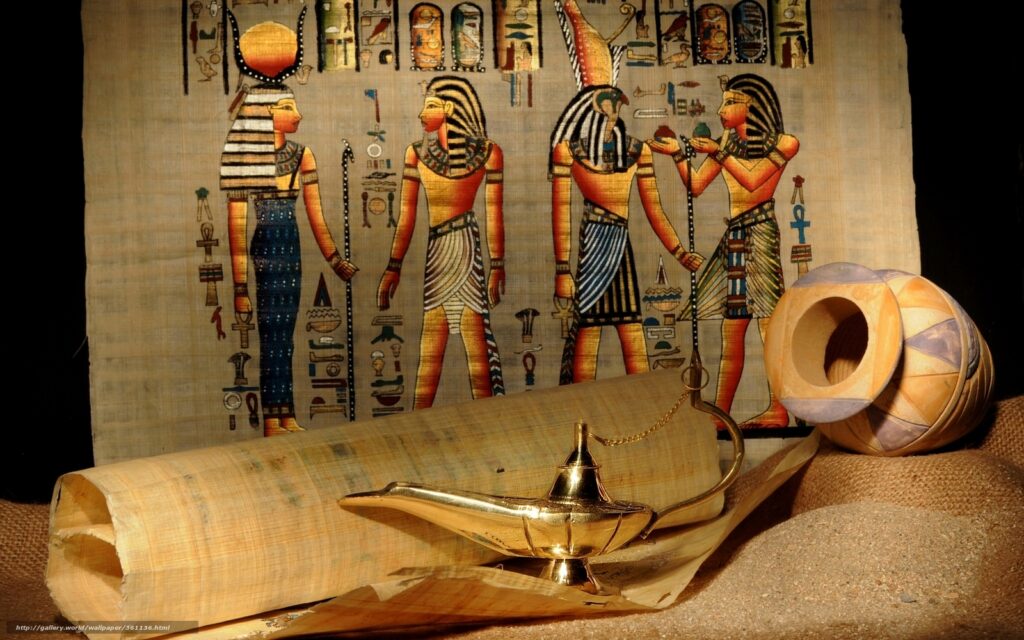
These artworks are more than mere decorations; they are windows into the past, offering glimpses of the lives and beliefs of ancient Egyptians. The artists, often descendants of a long line of papyrus craftsmen, infuse each piece with a reverence for their heritage.
Visitors, drawn by the uniqueness and authenticity of papyrus art, often leave with a tangible piece of Egypt’s ancient history, carrying with them a connection to a civilization that shaped the course of human progress.
Conclusion: An Ode to Craftsmanship
In the markets of Egypt, the products that grace the stalls are more than mere commodities; they are testaments to the enduring spirit of human creativity and skill. Each item, from the fragrant spices to the delicate papyrus art, carries within it a piece of Egypt’s rich cultural tapestry.
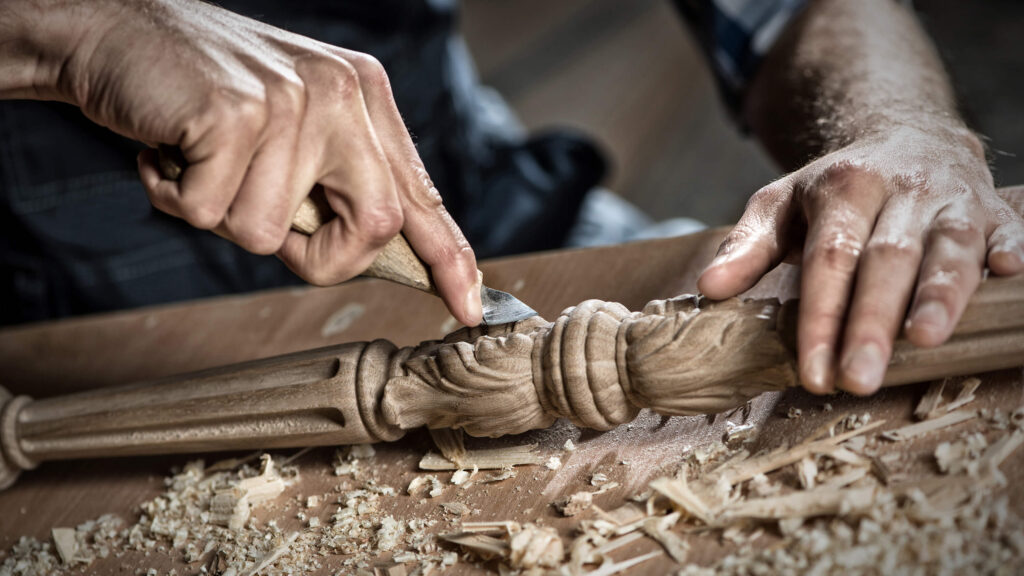
As visitors peruse the stalls, they are not merely shopping; they are immersing themselves in a living museum of craftsmanship and tradition. Every purchase becomes a souvenir, not only of a journey through the markets but of a connection forged with the artisans who poured their hearts and souls into their creations.
These products, with their unique stories and exquisite artistry, are not bound by time or place. They are bridges that span generations, linking the present with the past in a celebration of the enduring legacy of Egypt’s vibrant markets.
6. Culinary Adventures in Egyptian Markets: A Feast for the Senses
Egyptian markets are not only a treasure trove of products and crafts but also a veritable haven for culinary enthusiasts. The air is alive with the aromas of sizzling grills, fragrant spices, and the sweet allure of freshly baked pastries. From savory street food to delectable regional specialties, the markets offer a tantalizing journey through the rich tapestry of Egyptian cuisine.
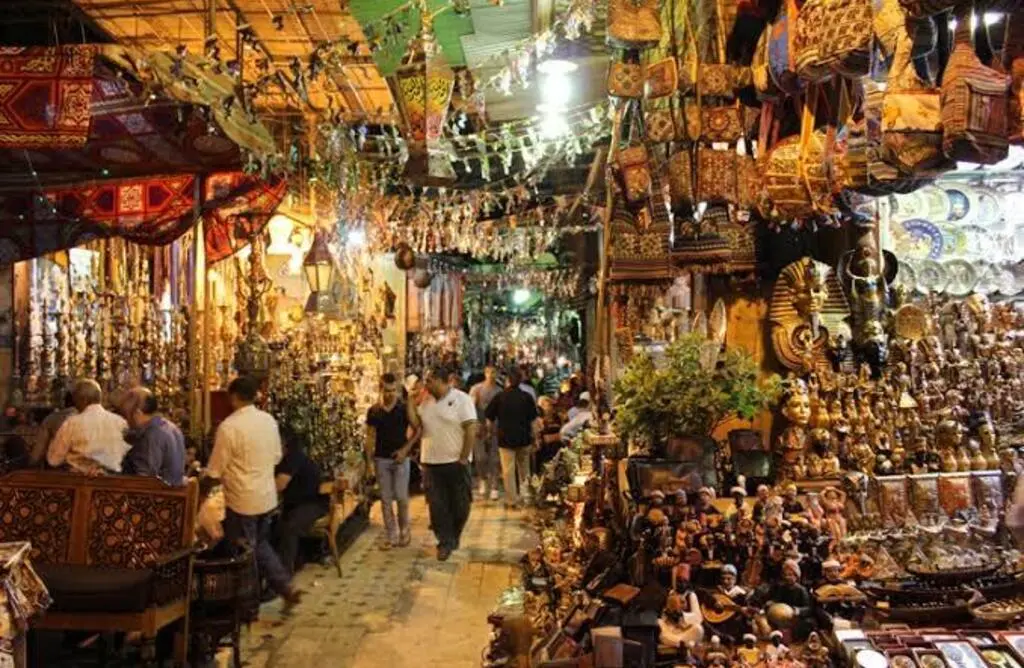
A.Diverse and Delectable Offerings
As one meanders through the labyrinthine alleys of Egyptian markets, a symphony of flavors unfolds at every turn. Vendors hawk an array of delectable offerings, from steaming pots of lentil soup to skewers of succulent kebabs. The markets are a culinary mosaic, where traditional recipes intermingle with contemporary twists, creating a gastronomic experience that caters to every palate.
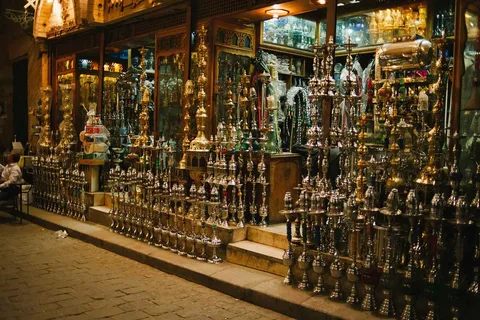
B.Must-Try Dishes: Koshary, Falafel, and Baklava
No culinary journey through Egypt would be complete without indulging in some of the country’s iconic dishes. Koshary, a humble yet hearty concoction of rice, lentils, pasta, and chickpeas, crowned with a tangy tomato sauce and crispy fried onions, exemplifies the art of simplicity and flavor fusion.
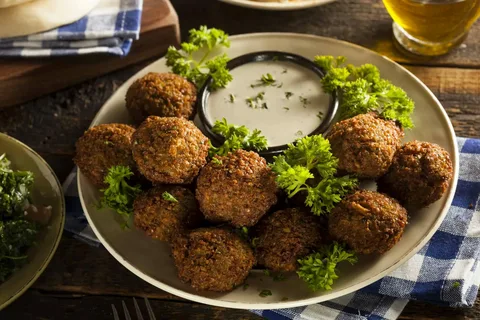
Falafel, those golden-brown orbs of chickpea and herb goodness, are a staple of Egyptian street food. Crispy on the outside, yet moist and flavorful on the inside, falafel epitomizes the balance of textures and tastes that make Egyptian cuisine a true delight.
And then there’s baklava, a symphony of flaky pastry, honey, and nuts that titillate the taste buds. The delicate layers of phyllo dough, soaked in sweet syrup, give way to the satisfying crunch of pistachios or walnuts, creating a dessert that is nothing short of a masterpiece.
C.Savoring Authentic Egyptian Cuisine
One of the most enchanting aspects of indulging in Egyptian cuisine within the markets is the sensory extravaganza that accompanies each bite. The rhythmic clang of metal against metal as vendors grill kebabs over open flames, the savory scent of cumin and coriander wafting through the air, and the vibrant colors of fresh herbs and vegetables all combine to create an immersive culinary experience.
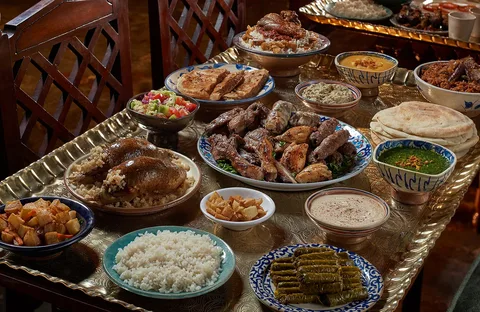
Sitting down at a bustling market eatery, with the hum of conversation and the sizzle of grills as a backdrop, is akin to stepping into the heart of Egyptian culture. Here, locals and visitors alike come together, united by a shared appreciation for the flavors that define this land.
There’s a palpable sense of camaraderie as diners pass around plates, exchanging smiles and stories over shared dishes. It’s an experience that transcends language barriers, forging connections through the universal language of food and the joy it brings.
D.Date Sweets: Nectar of the Nile
For those with a sweet tooth, Egyptian markets hold a special treasure: date sweets. Dates, a symbol of prosperity and abundance in Egyptian culture, are transformed into an array of delectable treats. From date-filled pastries to date-studded puddings, these sweets are a testament to the ingenuity of local confectioners.

The natural sweetness of dates, combined with a delicate interplay of spices and nuts, creates desserts that are simultaneously indulgent and nourishing. Each bite is a tribute to the rich agricultural heritage of Egypt and the bounty that the Nile Delta provides.
7. Cultural Experience and Interaction: The Heartbeat of Egyptian Markets
Egyptian markets are more than just places of commerce; they are living, breathing crucibles of cultural exchange. Here, beneath the fluttering awnings and amidst the lively throngs, a dance of shared experiences unfolds, where locals and tourists converge, forging connections that transcend borders and languages.
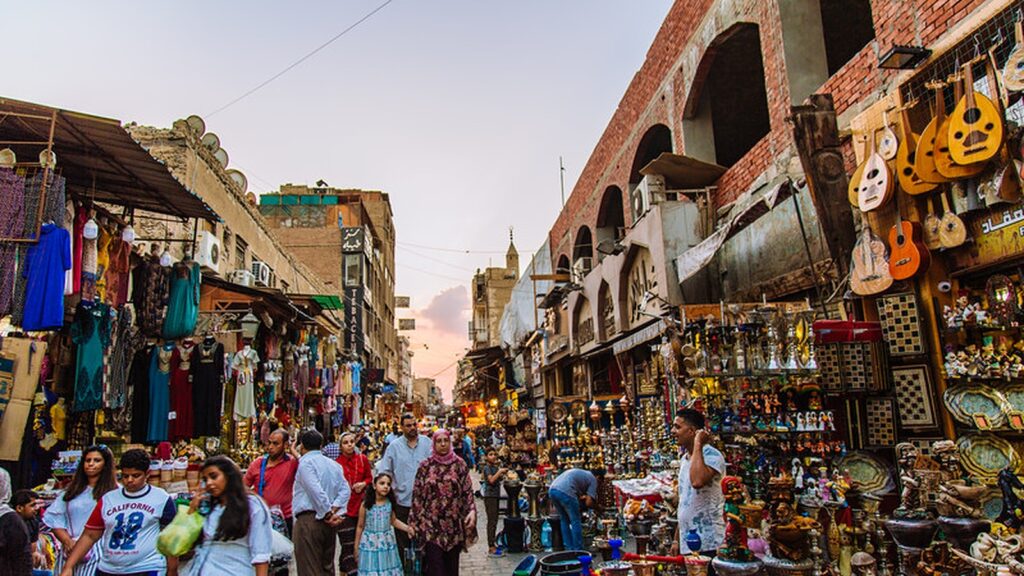
Cultural Exchange: Bridges of Understanding
As one navigates the bustling alleys of Egyptian markets, a kaleidoscope of languages, accents, and dialects mingles in the air. It is a testament to the power of these marketplaces to draw individuals from every corner of the globe, each seeking to partake in the unique tapestry of Egyptian culture.
The markets serve as bridges of cultural exchange, where ideas are shared, traditions are compared, and bonds are formed. Visitors have the opportunity to engage with local vendors, to learn about their crafts and the stories woven into each product. They leave with not only souvenirs but with a deeper appreciation for the people who craft them.
Conversely, locals take pride in sharing the treasures of their heritage. They offer insights into the historical significance of certain products, or regale visitors with stories of the customs that have been passed down through generations. It’s a two-way street, a give-and-take of knowledge and understanding that enriches both parties.
8. Markets as Social Hubs: Weaving the Fabric of Community
Beyond their economic importance, markets are the lifeblood of local communities. They serve as more than just places of transaction; they are social hubs where neighbors gather to exchange news, catch up on each other’s lives, and celebrate shared traditions.
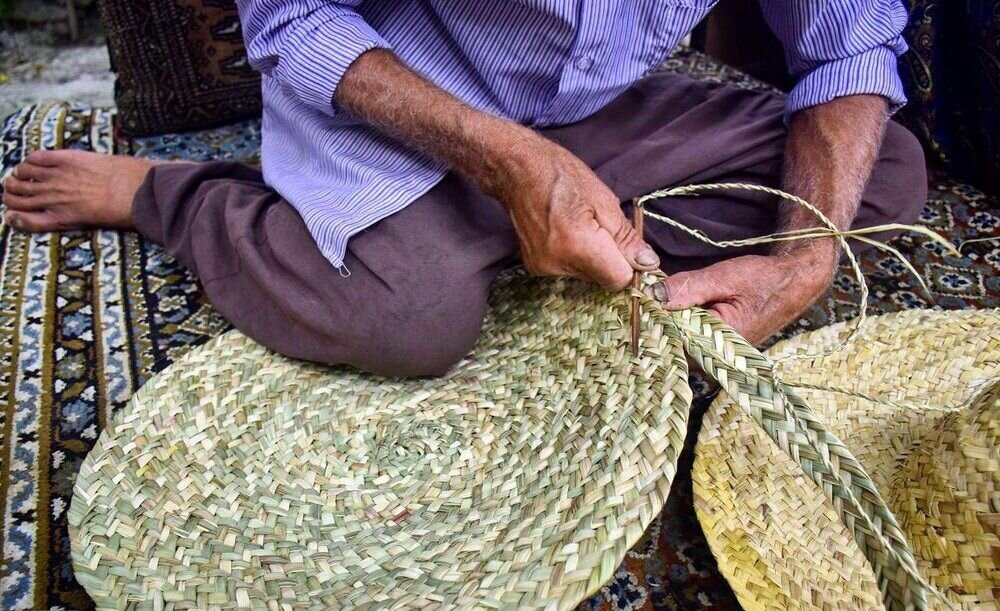
In Egyptian markets, the communal gathering extends far beyond the exchange of goods. It’s a space where relationships are nurtured, where friendships are forged over cups of tea or a shared platter of street food. The vendors, often familiar faces within the community, become more than just sellers; they become integral members of the social fabric, known by name and greeted with warmth.
It’s not uncommon to witness impromptu musical performances, with the strumming of ouds and the lilting melodies of traditional songs filling the air. Laughter and animated conversations form a symphony of human interaction, creating an atmosphere that is as welcoming as it is invigorating.
9. Anecdotes and Stories: Windows into Unique Experiences
The markets are repositories of countless stories, each stall and vendor a potential narrator. Every corner holds the potential for a unique encounter, a moment of connection that transcends the transactional nature of commerce Street Markets in Egypt.
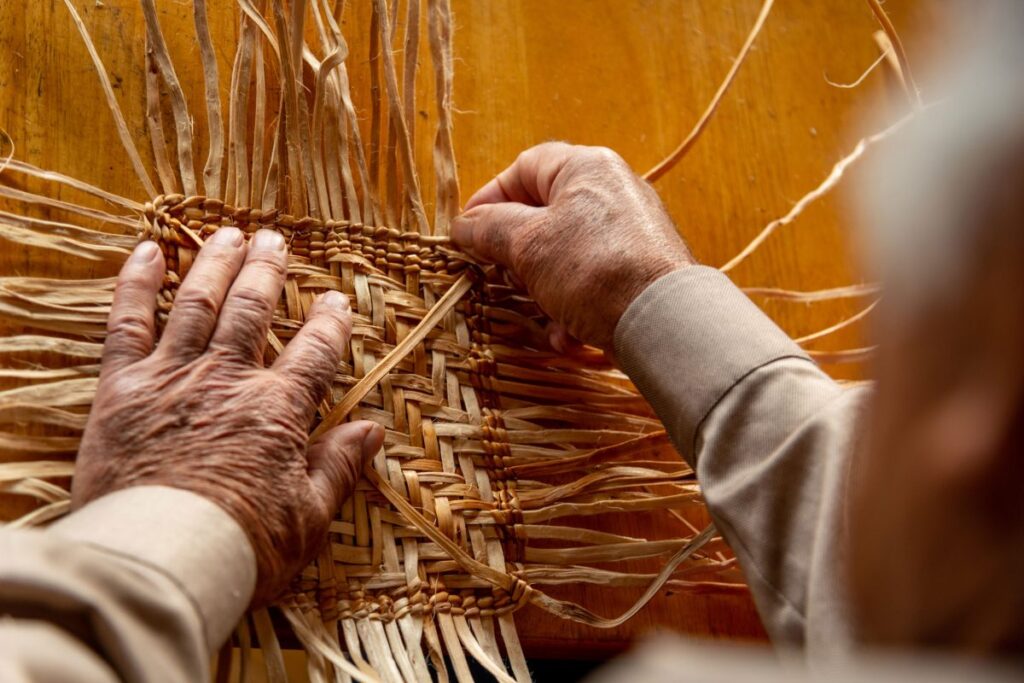
Street Markets in Egypt One might chance upon a skilled craftsman, his hands weathered from years of practice, weaving intricate patterns into a piece of fabric. Through a shared smile and a few words exchanged, a glimpse into the artistry and dedication that goes into each creation is revealed in Markets in Egypt.
Or perhaps, in a quieter corner, a vendor might share a story of a particular spice blend, passed down through generations, its ingredients a closely guarded family secret. In that moment, the visitor becomes not just a customer, but a participant in a tradition that stretches back in time.
In these Street Markets in Egypt, the anecdotes and stories become windows into the lives and passions of the people who inhabit them. They serve as reminders that behind every product, every stall, lies a human story, a testament to the resilience, creativity, and spirit of the Egyptian people.
10. Preservation Efforts and Sustainability: Safeguarding Egypt’s Market Heritage
Street Markets in Egypt In the face of rapid modernization and evolving consumer trends, Egyptian markets stand as bastions of tradition, Street Markets in Egypt resilience, and cultural heritage. Efforts to preserve their authenticity are not only critical to safeguarding Egypt’s rich history but also to ensuring a sustainable future for generations to come Street Markets in Egypt.
A.Balancing Tradition with Modernization
Street Markets in Egypt As Egypt continues to embrace modernity and technological advancement, the delicate balance between preserving tradition and embracing progress becomes increasingly important. The challenge lies in finding ways to integrate modern amenities and conveniences without compromising the authenticity and charm that define these Street Markets in Egypt.
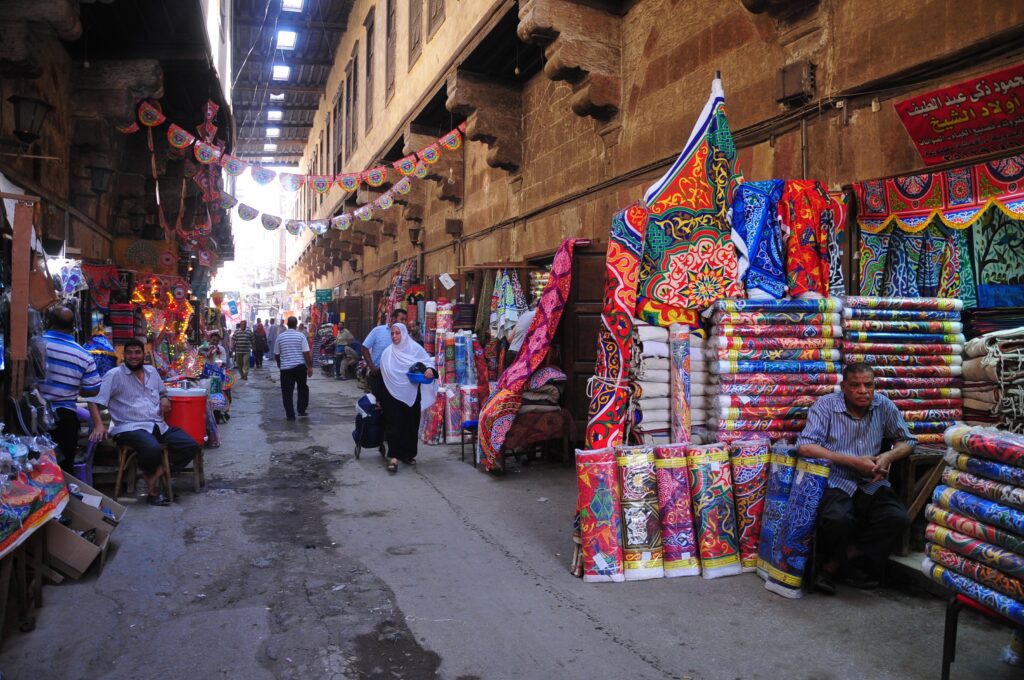
Street Markets in Egypt One notable example is the implementation of eco-friendly infrastructure. Market authorities have introduced energy-efficient lighting and waste management systems, reducing the environmental footprint while maintaining the unique ambiance of the markets. These initiatives demonstrate that progress need not come at the expense of heritage Street Markets in Egypt.
B.Sustainable Practices: Nurturing the Environment
Street Markets in Egypt In response to the global call for sustainable living, Egyptian markets have taken significant steps towards implementing eco-friendly practices. One key area of focus is packaging. Vendors and artisans are increasingly opting for biodegradable and recyclable materials, minimizing waste and reducing the environmental impact of market activities in Street Markets in Egypt.
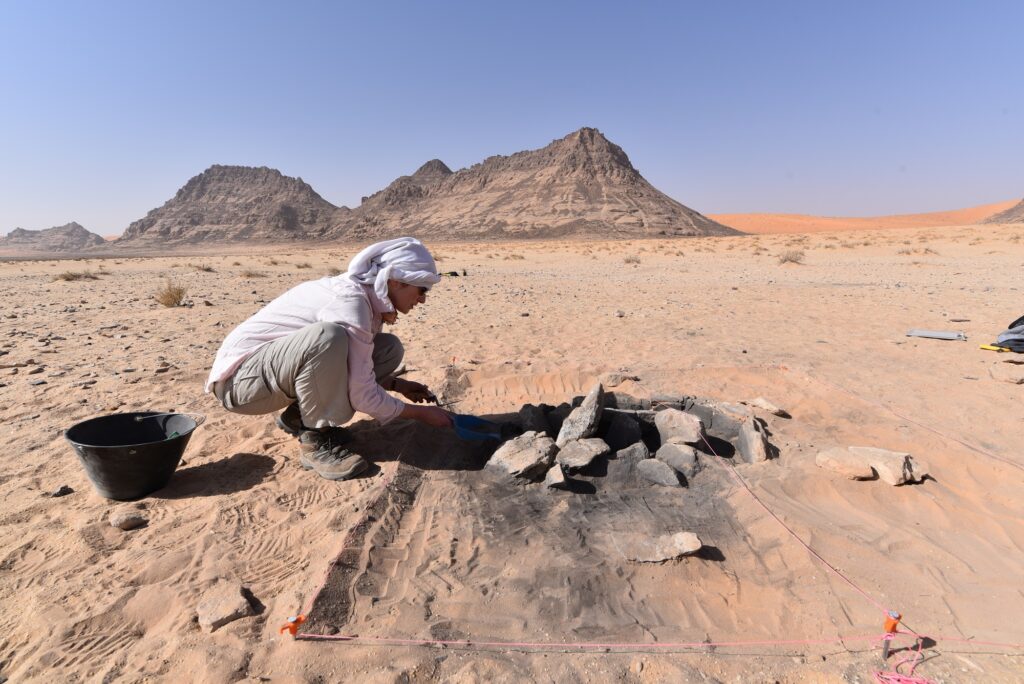
Street Markets in Egypt Local artisans, too, have embraced sustainability in their craft. By utilizing natural, locally sourced materials and adopting traditional techniques, they create products that not only resonate with authenticity but also reflect a commitment to environmentally conscious production Markets in Egypt.
Street Markets in Egypt Additionally, markets have become hubs for sustainable agriculture initiatives. Local growers and farmers are partnering with market vendors to provide fresh, locally sourced produce, reducing the carbon footprint associated with transportation and promoting a more sustainable approach to food consumption in Street Markets in Egypt.
C.Supporting Local Artisans: Nurturing Craftsmanship
Street Markets in Egypt One of the cornerstones of preserving market authenticity lies in supporting local artisans. These skilled craftsmen and women are the lifeblood of the markets, their creations embodying the spirit and heritage of Egyptian culture Street Markets in Egypt.
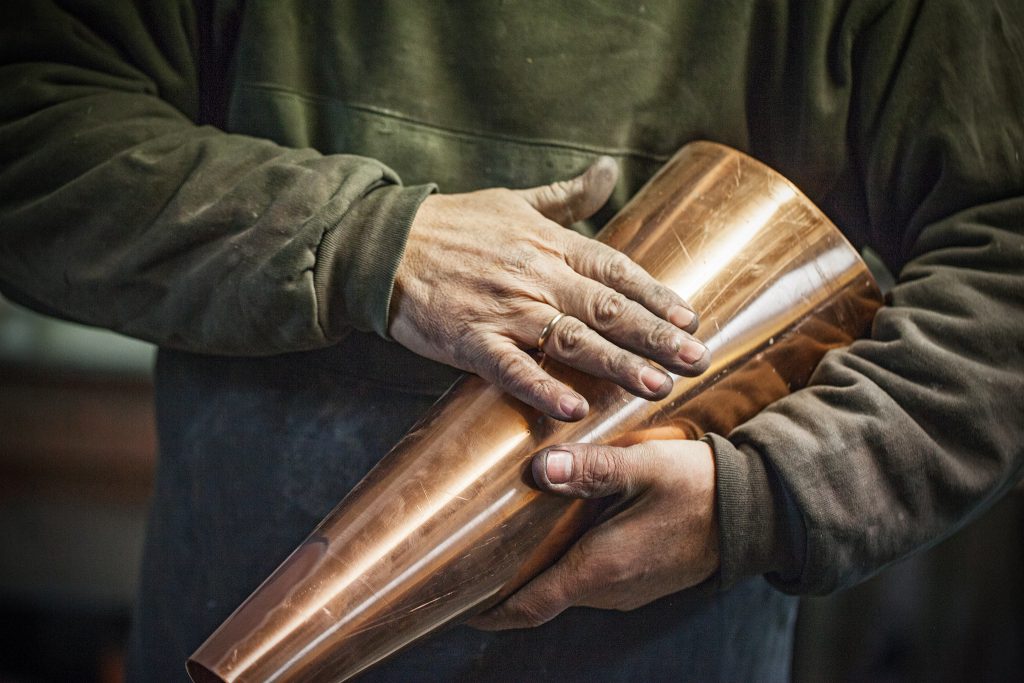
Street Markets in Egypt Initiatives aimed at providing training, resources, and market access for artisans have flourished. These efforts empower craftsmen to continue their traditions, ensuring that the skills and knowledge passed down through generations remain alive and vibrant in street Markets in Egypt.
Market preservation organizations collaborate with artisans to develop marketing strategies and expand their reach, both domestically and internationally. By promoting the work of local craftspeople, these initiatives not only celebrate their talent but also foster a sustainable economic ecosystem within the markets Street Markets in Egypt.
D.Responsible Tourism: Preserving for Posterity
Street Markets in Egypt Tourism plays a pivotal role in the vitality of Egyptian markets. Responsible tourism practices are essential to ensure that the influx of visitors enhances rather than jeopardizes the market experience of Street Markets in Egypt.
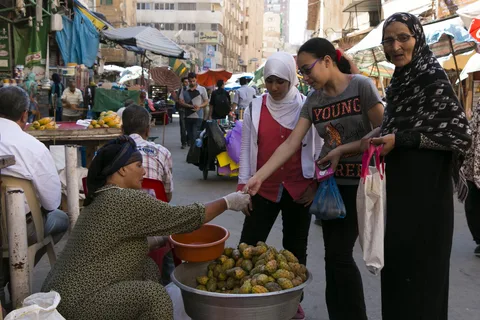
Street Markets in Egypt Guided tours and educational programs provide visitors with insights into the cultural and historical significance of the markets, fostering a deeper appreciation for the traditions they embody. By understanding the value of these spaces, tourists are more likely to engage in respectful and considerate behavior while exploring Street Markets in Egypt.
Street Markets in Egypt Local authorities and market associations are working together to implement policies that prioritize the preservation of market heritage. These include regulations regarding crowd management, preservation of historical structures, and guidelines for sustainable business practices in Street Markets in Egypt.
Conclusion:
Discovering the Heartbeat of Egypt in its Markets
Egyptian street markets are not just places to buy and sell; they are living, breathing entities that pulse with the essence of Egypt itself. They are the threads that weave together the rich tapestry of the country’s history, culture, and commerce. Street Markets in Egypt As we reflect on their profound importance, it becomes clear that these markets are more than economic hubs; they are the lifeblood of Egyptian societyStreet Markets in Egypt.
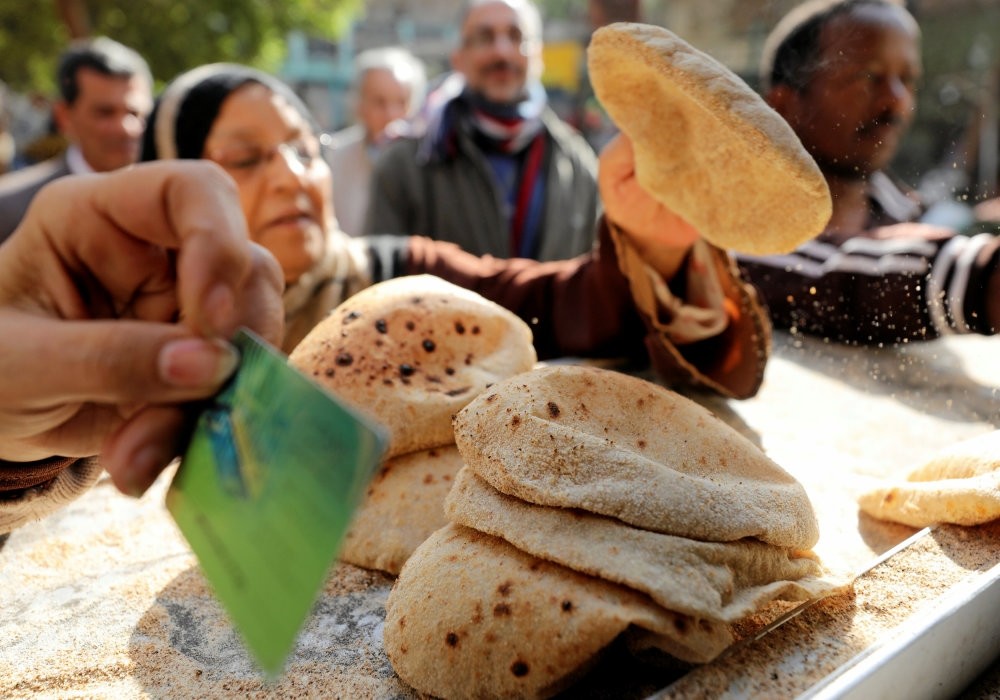
Street Markets in Egypt In these markets, time seems to stand still, allowing us to step back in history and experience the traditions that have shaped this remarkable nation. The cobbled alleys of Khan El Khalili whisper secrets from centuries past, while the vibrant tapestries of Aswan’s Nubian Market tell stories of a culture that has thrived along the banks of the Nile for millenniaStreet Markets in Egypt.
Street Markets in Egypt Every corner, every stall, is a window into a world of craftsmanship, where artisans pour their hearts and souls into their creations. The scent of exotic spices mingles with the aroma of freshly baked bread, creating an olfactory symphony that is uniquely Egyptian. Here, the past mingles harmoniously with the present, and the echoes of ancient civilizations reverberate in every stone and tile Street Market in Egypt.
Street Markets in Egypt Embarking on a journey through these markets is not just a shopping excursion; it is an enriching experience that leaves an indelible mark on the soul. It is an invitation to immerse oneself in a cultural landscape that is as diverse as it is inviting. From the bustling streets of Cairo to the tranquil shores of Aswan, each market offers a unique chapter in the grand narrative of Egypt’s vibrant street markets.
Street Markets in Egypt For those willing to venture forth, the rewards are boundless. The memories forged amidst the hustle and bustle of these markets are etched in the heart forever. The intricate textiles, the savory street food, the stories exchanged with local vendors—these are the souvenirs that truly endure.
In every sense, exploring Egyptian street markets is an authentic exploration, an opportunity to peel back the layers of time and engage with a culture that has endured for millennia. It is an enriching experience, a chance to learn, to connect, and to be inspired Street Markets in Egypt.
So, I invite you, dear reader, to embark on your own journey through these vibrant markets. Allow yourself to be swept up in the sensory symphony, to savor the flavors, and to be captivated by the stories that await at every turn. Let the unique blend of history, culture, and commerce that defines these markets envelop you in an experience that is as enriching as it is memorable street Markets in Egypt.
Street Markets in Egypt In doing so, you become not just a visitor, but a participant in the living heritage of Egypt. You become part of a continuum that stretches back through the ages, a link in the chain of those who have been captivated by the allure of these markets. And in your exploration, you help preserve and celebrate the legacy that these markets represent—a legacy that will continue to inspire generations to come to Street Markets in Egypt.






Comment (0)